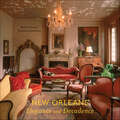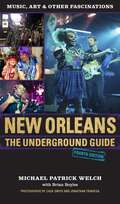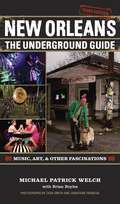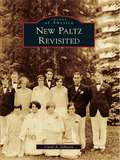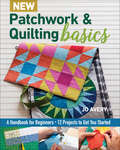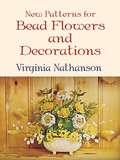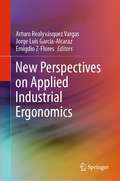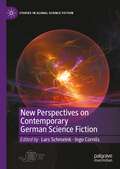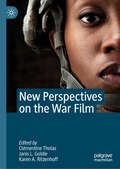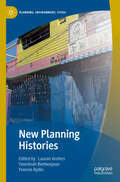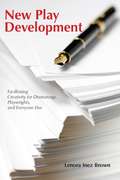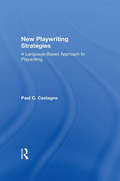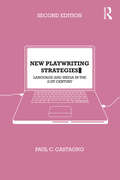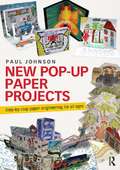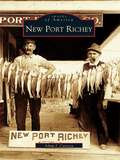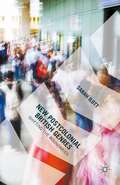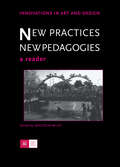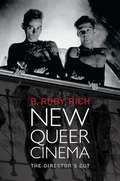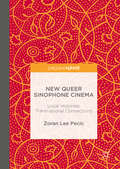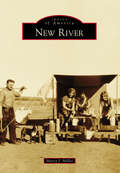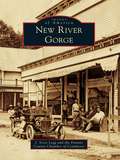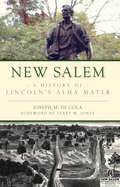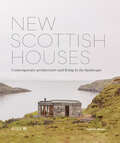- Table View
- List View
New Orleans: Elegance and Decadence
by Richard Sexton Randolph DelehantySecond edition offers a look into the soulful homes and gardens of 1990s NOLA creatives, updated with a new layout, larger photos, and a narrative that includes the city's recent historyFor everyone who fantasizes about interiors that evoke an artistic world of color, myth, and romanceThe first edition sold more copies (90,000-plus) than any other photographic book about New Orleans in the city&’s history
New Orleans: The Canal Streetcar Line
by Edward J. BranleyThe clanging of a streetcar's bell conjures images of a time when street railways were a normal part of life in the city. Historic Canal Street represents the common ground between old and new with buses driving alongside steel rails and electric wires that once guided streetcars.New Orleans was one of the first cities to embrace street railways, and the city's love affair with streetcars has never ceased. New Orleans: The Canal Streetcar Line showcases photographs, diagrams, and maps that detail the rail line from its origin and golden years, its decline and disappearance for almost 40 years, and its return to operation. From the French Quarter to the cemeteries, the Canal Line ran through the heart of the city and linked the Creole Faubourgs with the new neighborhoods that stretched to Lake Pontchartrain.
New Orleans: The Underground Guide, 4th Edition
by Michael Patrick Welch Brian Boyles Zack Smith Jonathan TraviesaNew Orleans: The Underground Guide shows visitors how to experience the Big Easy like a local, looking past staples like beignets and Bourbon Street to reveal a city bursting with contemporary and experimental art, genre-busting DJs, international cuisines, and even kid-friendly activities.This fully updated edition offers an expansive collection of alternative recommendations for exploring the city of Mardi Gras, brass bands, and weekly festivals. Featuring over two hundred new entries on local bands, rappers, restaurants with live music, galleries, and more, this guidebook takes readers on a one-of-a-kind journey through New Orleans, giving advice on everything from what thrift stores and bookshops to visit to what bands to catch in concert and what parades to attend.Lead author Michael Patrick Welch provides a detailed guide of the less traditional, more adventurous side of New Orleans, from bars that hold readings of poetry and erotic literature to costume shops that sell handmade masks, party supplies, and all the parade throws you can carry. Drawing on the wisdom of New Orleans celebrities, journalists, artists, and musicians from throughout the Crescent City, the fourth edition of New Orleans: The Underground Guide is an authentic and reliable resource for where locals listen to music, art hop, shop, eat, drink, and let loose.
New Orleans: The Underground Guide, 4th Edition
by Michael Patrick Welch Brian Boyles Zack Smith Jonathan TraviesaRed beans and rice, trad jazz, and second lines are the Big Easy's calling cards, but beyond where the carriage rides take you is a city brimming with genre-defying music, transnational cuisine, and pockets of wild, artistic locals that challenge preconceived notions of what it means to be New Orleans. With a respectful nod to the traditional and a full embrace of the obscure, New Orleans: The Underground Guide is a resource for discovering the city as it really is -- as much brass bands and boas as it is bounce and bicycle tours. From a speakeasy in the Bywater neighborhood to the delightfully sketchy vibe of St. Roch Tavern, lead author Michael Patrick Welch uncovers an unexpected tableau of musicians, venues, and novel ways to pass the bon temps. Contents include but are not limited to: where to get naked, how to make the most of Mardi Gras according to banjo player Geoff Douville, what to order from the delicious Slavic menu at Siberia, where to find the New Orleans Giant Puppet Festival, how to catch a performance by the New Movement comedy troupe, where to rent a kayak, and how to get in on the "bed and beverage" experience at the Royal Street Inn.
New Paltz Revisited
by Carol A. JohnsonNew Paltz was established in 1678 by a small group of Huguenot refugees and their families. These pioneers settled into the fertile Wallkill River Valley with the majestic Hudson River to the east and the Shawangunk Mountains defining the western border. These families endured what today would be insurmountable odds, yet for generations they survived and constantly improved their quality of life. The homesteads of these patentee families still stand along historic Huguenot Street and are testaments to those who built them so long ago. Today New Paltz residents and visitors alike enjoy the various outdoor recreational activities, exceptional educational opportunities, and easy accessibility to nearby metropolitan areas. With carefully selected photographs and detailed text, New Paltz Revisited traces the history of New Paltz from the Colonial era to the present.
New Patchwork & Quilting Basics
by Jo AveryBuild your quilting skills with this beginner&’s guide featuring 12 modern projects using basic patchwork, appliqué, curves, and foundation paper piecing. Quilt designer Jo Avery has a wealth of experience teaching beginner and intermediate quilters at her popular workshops and retreats. In New Patchwork & Quilting Basics, she guides you through 12 quilt projects using basic pieced strips, squares, and triangles. Jo&’s easy-to-follow instructions make it easy to learn new skills while making your own stylish quilts and other projects. Before long, you&’ll have the confidence and expertise to tackle virtually any quilt pattern!
New Patterns for Bead Flowers and Decorations
by Virginia NathansonLavishly illustrated book, with easy-to-follow directions, shows how to fashion a host of exquisite, heirloom-quality beaded decorations, including calla lilies, potted plants, Christmas ornaments, pine cones, bridal bouquets, drapery tiebacks, and other attractive domestic accents. Step-by-step fundamentals and easy-to-master techniques. 23 color illustrations, 119 figures, and 102 photographs.
New Perspectives on Applied Industrial Ergonomics
by Jorge Luis García-Alcaraz Arturo Realyvásquez Vargas Emigdio Z-FloresThis book reports the most recent, advanced, successful, and real applications of ergonomics in order to improve the human well-being and performance in a short term, as well as the organizational performance in a long term. The book is organized as follows: Physical Ergonomics. This section reports case studies where physical risk factors are presented in the workplace, such as physical risk factors including uncomfortable body postures, repetitive movements, force application, manual material handling, and physical environmental conditions. In addition, case studies must report applications from physical ergonomics methods, for instance, RULA, REBA, OWAS, NIOSH, JSI, Suzane Rodgers, ERIN, among others. Cognitive Ergonomics. This section reports the implementation of ergonomic tools, techniques, and methods in real case studies. These applications are aimed to know, decrease, and control cognitive and psychological risk factors, such as mental workload, information processing, situation awareness, human error identification, and interface analysis. These applications may include the following methods NASA-TLX, SWAT, CWA, SHERPA, HET, TAFEI, SAGAT, SART, SACRI, QUIS, SUMI, to mention a few of them. Macro-ergonomics. This section is focused on the analysis, design, and evaluation of work systems. It reports case studies where risk factors are beyond a specific workstation. These risk factors may include supervision styles, teamwork management, task variety, social relationships, organizational culture, organizational communication, technology, work schedules, and motivation, among others. In addition, case studies report the application of macro-ergonomic methods, such as MOQS, focus group, participatory ergonomics, HITOP, MAS, and MEAD, among others.
New Perspectives on Contemporary German Science Fiction (Studies in Global Science Fiction)
by Lars Schmeink Ingo CornilsNew Perspectives on Contemporary German Science Fiction demonstrates the variety and scope of German science fiction (SF) production in literature, television, and cinema. The volume argues that speculative fictions and explorations of the fantastic provide a critical lens for studying the possibilities and limitations of paradigm shifts in society. Lars Schmeink and Ingo Cornils bring together essays that study the renaissance of German SF in the twenty-first century. The volume makes clear that German SF is both global and local—the genre is in balance between internationally dominant forms and adapting them to Germany’s reality as it relates to migration, the environment, and human rights. The essays explore a range of media (literature, cinema, television) and relevant political, philosophical, and cultural discourses.
New Perspectives on the War Film
by Karen A. Ritzenhoff Clémentine Tholas Janis L. GoldieNew Perspectives on the War Film addresses the gap in the representation of many forgotten faces of war in mainstream movies and global mass media. The authors concentrate on the untold narratives of those who fought in combat and were affected by its brutal consequences. Chapters discuss the historically under-represented stories of individuals including women, African-American and Indigenous Soldiers. Issues of homosexuality and gender relations in the military, colonial subjects and child soldiers, as well as the changing nature of war via terrorism and bioterrorism are closely analyzed. The contributors demonstrate how these viewpoints have been consistently ignored in mainstream, blockbuster war sagas and strive to re-integrate these lost perspectives into current and future narratives.
New Planning Histories (Planning, Environment, Cities)
by Yvonne Rydin Lauren Andres Yasminah BeebeejaunThis book brings new scholarship to students on the origins and development of planning thoughts, theories, policies, institutions and practices, outlining how these have shaped planning as a state and professional activity. It showcases the work of leading scholars working to develop new histories of planning, giving particular attention to the impact of colonisation and its approach to race, which has significantly impacted planning processes, as well as to the importance of women and people of colour as significant actors in the development of planning policy and practices. The chapters bring a much-needed global and comparative perspective, including views from the &‘Global South&’ and from countries where planning remains an under-resourced and under-recognised profession. This is an essential resource for advanced undergraduate and graduate students in planning, architecture and urban studies.
New Play Development: Facilitating Creativity for Dramaturgs, Playwrights, and Everyone Else
by Lenora Inez Brown"This is a book for dramaturgs of new work, but it is also a particularly effective book for anyone working on new plays: playwrights, directors, producers, even actors. Lenora skillfully dissects the process of workshopping new writing, and clearly defines the roles for all involved. I learned not only how to make a new play workshop more effective, but how to approach my writing and my directing, and how to meaningfully collaborate with others in this unique process. This is a necessary handbook for anyone working on new plays today." --Anne Marie Cammarato, Director
New Playwriting Strategies: A Language-Based Approach to Playwriting
by Paul C. CastagnoNew Playwriting Strategies offers a fresh and dynamic approach to playwriting that will be welcomed by teachers and aspiring playwrights alike.
New Playwriting Strategies: Language and Media in the 21st Century (A\theatre Arts Book Ser.)
by Paul C. CastagnoNew Playwriting Strategies has become a canonical text in the study and teaching of playwriting, offering a fresh and dynamic insight into the subject. This thoroughly revised and expanded second edition explores and highlights the wide spread of new techniques that form contemporary theatre writing, as well as their influence on other dramatic forms. Paul Castagno builds on the innovative plays of Len Jenkin, Mac Wellman, and the theories of Mikhail Bakhtin to investigate groundbreaking new techniques from a broad range of contemporary dramatists, including Sarah Ruhl, Suzan Lori-Parks and Young Jean Lee. New features in this edition include an in-depth study of the adaptation of classical texts in contemporary playwright and the utilizing new technologies, such as YouTube, Wikipedia and blogs to create alternative dramatic forms. The author’s step-by-step approach offers the reader new models for: narrative dialogue character monologue hybrid plays This is a working text for playwrights, presenting a range of illuminating new exercises suitable for everyone from the workshop student to the established writer. New Playwriting Strategies is an essential resource for anyone studying and writing drama today.
New Pop-Up Paper Projects: Step-by-step paper engineering for all ages
by Paul JohnsonNew Pop-Up Paper Projects is an inspirational book for everyone who wants to learn and share the magic of pop-up paper engineering. Illustrated throughout with colour diagrams and photographs, this book guides you through basic techniques and foundation skills, offers advice on classroom planning and health and safety and shows you how to ensure that learners of all ages can develop and progress their skills. Guiding you through 90-, 180- and 360-degree engineering, this book presents step-by-step instructions and ideas for over 200 cross-curricular themes, from cityscapes to magical creatures. Aiming to challenge and inspire, Paul Johnson uses over 150 paper-engineering techniques, including: storybooks pop-ups without folds zigzag pop-ups pulleys, wheels and levers asymmetrical pop-ups intricate toy theatres diagonal pop-ups with movables. This book, brimming with pop-up techniques and how to teach them, is for everyone – from the self-styled ‘visually illiterate’ to the art graduate, from parents keeping creativity alive at home to classroom teachers planning an engaging curriculum for their class of 30 plus pupils.
New Port Richey
by Adam J. CarozzaNew Port Richey, Florida, like many cities between Jacksonville and Tampa, can thank Henry Plant's 1885 railroad for its phenomenal growth. Thirty-five miles northwest of Tampa, in West Pasco County, New Port Richey eventually hosted its own railway connection right through downtown. City planners constructed the community in a grid, naming north-south streets after Presidents and east-west streets after states. The arrival of the U.S. Post Office in 1915 confirmed this city's importance and put New Port Richey on the map. Hotels, banks, and businesses sprang up in the downtown area to serve those who came in search of a better life. Fishing on the Pithlachascotee River and in the Gulf of Mexico attracted many visitors, as did the construction of golf courses. Businessmen then and now recognized that this area had "that special something" to catch the attention and the hearts of people from all states north of Florida.
New Postcolonial British Genres: Shifting the Boundaries
by Sarah IlottThis study analyses four new genres of literature and film that have evolved to accommodate and negotiate the changing face of postcolonial Britain since 1990: British Muslim Bildungsromane, gothic tales of postcolonial England, the subcultural urban novel and multicultural British comedy.
New Practices - New Pedagogies: A Reader (Innovations in Art and Design)
by Malcolm MilesWith radical changes happening in arts over the past two decades, this book brings us up to date with the social and economic contexts in which the arts are produced. Influential and knowledgable leaders in the field debate how arts education - particularly in visual art - has changed to meet new needs or shape new futures for its production and reception. Opening up areas of thought previously unexplored in arts and education, this book introduces students of visual culture, peformance studies and art and design to broad contextual frameworks, new directions in practice, and finally gives detailed cases from, and insights into, a changing pedagogy.
New Queer Cinema: The Director's Cut
by B. Ruby RichB. Ruby Rich designated a brand new genre, the New Queer Cinema (NQC), in her groundbreaking article in the Village Voice in 1992. This movement in film and video was intensely political and aesthetically innovative, made possible by the debut of the camcorder, and driven initially by outrage over the unchecked spread of AIDS. The genre has grown to include an entire generation of queer artists, filmmakers, and activists. As a critic, curator, journalist, and scholar, Rich has been inextricably linked to the New Queer Cinema from its inception. This volume presents her new thoughts on the topic, as well as bringing together the best of her writing on the NQC. She follows this cinematic movement from its origins in the mid-1980s all the way to the present in essays and articles directed at a range of audiences, from readers of academic journals to popular glossies and weekly newspapers. She presents her insights into such NQC pioneers as Derek Jarman and Isaac Julien and investigates such celebrated films as Go Fish, Brokeback Mountain, Itty Bitty Titty Committee, and Milk. In addition to exploring less-known films and international cinemas (including Latin American and French films and videos), she documents the more recent incarnations of the NQC on screen, on the web, and in art galleries.
New Queer Sinophone Cinema
by Zoran Lee PecicThis book looks closely at some of the most significant films within the field of queer Sinophone cinema. Examining queerness in films produced in the PRC, Taiwan and Hong Kong, the book merges the Sinophone with the queer, theorising both concepts as local and global, homebound as well as diasporic. Queerness in this book not only problematises the positioning of non-normative desires within the Sinophone; it also challenges Eurocentric critical perspectives on filmic representation that are tied to the idea of the binary between East/West. New Queer Sinophone Cinema will appeal to scholars in Chinese and film studies, as well as to anyone who is interested in queer Chinese cinema.
New River (Images of America)
by Marcy J. MillerLong before the cavalry and stagecoaches traveled through on military roads and the Old Black Canyon Stage Road, the ancient Hohokam people relied on New River's peaks for fortresses and lookouts. In the late 1800s, the military sweep of the last native people, the Apache and Yavapai, rendered the region safe for settlers. Situated between the cool north and the hot, arid Salt River Valley below, New River became a key location for watering sheep and cattle driven between seasonal pastures. Ranches, such as the Triangle-Bar, sprang to life in the cactus-studded foothills. From the 1920s to the 1940s, the arrival of tough, capable homesteaders formed the community that thrives today. Still an unincorporated area of north Maricopa County, New River retains its western heritage and scenic desert vistas
New River Gorge
by J. Scott Legg Fayette County Chamber of CommerceToday visitors to the New River Gorge see a steep gorge filled with a lush hardwood forest. Before the railroad, the New River, with its whitewater rapids, was a barrier to trade, but with the 1873 completion of the Chesapeake and Ohio Railroad, the gorge came alive. By the 1890s, more than 30,000 people lived and worked in the gorge. Towns like Kaymoor, Nuttallburg, and Thurmond were hives of activity and melting pots of American immigrants who dug the coal that helped build the American dream. Times changed. By 1960, the easiest coal was gone, and miners moved to Midwest factories. Nature began to reclaim the gorge. The 1970s brought a rebirth. Whitewater rafters took on the rapids, and bridge builders built the New River Gorge Bridge. The forest has returned, and if you look under the canopy, you will see that the railroads, coal camps, and mine tipples have given way to rafters, rock climbers, and mountain bikers.
New Rules Next Week: Corita Kent's Legacy through the Eyes of Twenty Artists and Writers
by Corita Art CenterTwenty contemporary artists and writers reimagine Corita Kent's iconic creative manifesto.Known for her vibrant and powerful serigraphs, Corita Kent left an equally important legacy through her teaching. In the late 1960s, she and her students at the Immaculate Heart College developed their Art Department Rules. From "Consider everything an experiment" to "Be happy whenever you can manage it," these ten deceptively simple principles capture the magic of Corita's approach to creativity, culture, and activism. In this volume, ten writers and ten artists look back at the rules and show us how vital and resonant they remain today. The wide-ranging roster of contributors includes Vashti Harrison, Lisa Congdon, Natacha Ramsay-Levi, Dan Paley, and Erin Jang.COMPELLING AND INSPIRING ARTIST: Corita Kent was a Roman Catholic nun, a wildly popular pop artist, a social justice advocate, and a beloved art teacher. Her Art Department Rules continue to speak to people today. This book celebrates the way Corita's work resonates through contemporary art and offers inspiration for your own creative practice.TWENTY AMAZING CONTRIBUTORS: Illustrators, designers, educators, curators, former students and colleagues of Corita's—the illustrious contributors to this volume offer a kaleidoscope of perspectives on the artist's legacy. PERFECT GIFT: This book makes an impactful gift for creative minds, especially students. The ten rules offer encouragement and guidance to anyone who aspires to begin or expand an artistic practice.Perfect for:Fans of Corita Kent's artwork, teaching, and activismArt school students, creative professionals, and artists of all kindsDevotees of the "Pop Art Nun," Andy Warhol, Ben Shahn, and activist artFans of art- and activism-focused coffee table books, art retrospectives, and creativity workbooks like The Artist's Way
New Salem: A History of Lincoln's Alma Mater (Brief History)
by Foreword By Jones Joseph M. ColaIn 1829, eleven years after Illinois became the twenty-first state, New Salem was founded on a bluff above the Sangamon River. The village provided an essential sanctuary for a friendless, penniless boy named Abraham Lincoln, whose six years there shaped his education and nurtured his ambition. Eclipsed by the neighboring settlement of Petersburg, New Salem had dwindled into a ghost town by 1840. However, it reemerged in the early part of the twentieth century as one of the most successful preservation efforts in American history. Author Joseph Di Cola relates the full story of New Salem’s fascinating heritage.
New Scottish Houses: Contemporary architecture and living in the landscape
by Isabelle PriestNew Scottish Houses: Contemporary Architecture and Living in the Landscape brings together for the first time the best examples of contemporary rural houses in Scotland. Showcasing the new rural vernacular that has developed in Scotland over the past 20 years, it presents this rich seam of architecturally designed houses as a new, exciting and specific movement that aims to be distinctly Scottish.Exploring the fusion of modern design with Scotland's rugged natural beauty, each case study explores a curate collection of contemporary homes that push the boundaries of design - from remote highlands to coastal hideaways. These homes have established a new vernacular for the region inspired by historical blackhouses, and place the buildings within an older 'pre-English' tradition of long houses: revising these lost traditions as more authentically Scottish, and more closely tied to Scotland's landscape, geology and climate.Featuring striking photographs and insightful commentary, this beautiful book celebrates how architects and homeowners are creating spaces that are both sustainable and inspirational, reflecting the evolving identity of Scotland's built environment in the 21st century.Architects featured include: Mary Arnold Forster Paper Igloo Dualchas Brown and Brown Architects Denizen Works
